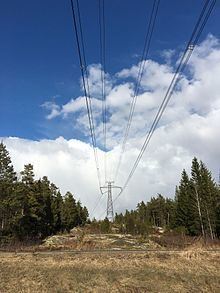Manufacturer of conductor/cable ABB Total length 233 km (145 mi) Commissioned 1989 | Expected 2011 (2nd cable) Power rating Number of poles 2 | |
 | ||
Type of current High-voltage direct current | ||
Fenno–Skan is the designation of the high voltage direct current transmission between Dannebo in Sweden and Rauma in Finland.
Contents
History
Fenno–Skan was inaugurated in 1989. Taken into commercial operation in November 1989, Fenno–Skan was the longest submarine power cable in the world. It was also the first HVDC cable with 400 kV voltage and a rated power of 500 MW.
Description
The Fenno–Skan is a monopolar system with a maximum transmission rate of 550 megawatts (MW) at a voltage of 400 kV. It would be converted to become a bipole. The cable was manufactured by ABB.
The total length of Fenno–Skan is 233 kilometres (145 mi), of which 200 kilometres (120 mi) is a submarine cable on the bottom of the Gulf of Bothnia. At the Swedish end the cable directly enters the Dannebo static inverter plant near the Forsmark nuclear power station about 1 kilometre (0.62 mi) from the coast at 60°24'16"N 18°8'4"E. However, the electrode line from the static inverter plant to the ground electrode situated at 60°35'51"N 17°57'46"E is built as overhead line. It is a line with two conductors on wooden poles, which runs partly on its course past another powerline.
There is a 33 kilometres (21 mi) long overhead line section from the coast in Finland at 61°4'37" N, 21°18'18" E to the static inverter station in Rauma, situated at 61°9′7″N 21°37′32″E.
The ground electrode in Finland is situated near Rantala. From there an overhead electrode line on wooden poles runs first in Northeast, than in Northern direction until Ruokalho, where it meets the overhead line with two high voltage conductors. From Ruokalho to Rauma static inverter plant the electrode line is fixed on a small crossbar above the high voltage conductors of Fenno–Skan and serves as ground conductor. In opposite to a normal ground conductor it is mounted on insulators equipped with surge arrestors.
Operators
Fenno–Skan is operated by the Finnish and Swedish transmission system operators Fingrid and Svenska Kraftnät.
Fenno–Skan 2
Fenno–Skan 2 is the second cable of the Finland–Sweden submarine power connection. 800 MW, 500 kV subsea transmission connection was laid in 2011 by the cable laying ship SC Skagerrak, and it cost €150 million. The cable was manufactured by Nexans Norwegian plant in Halden. Two converter stations were supplied by ABB. Compare with Fenno–Skan 1, the Swedish converter station is located in Finnböle. The Fenno–Skan 2 cable is connected to the converter station by a 70 kilometres (43 mi) long DC overhead line. The pylons of this line are "classic HVDC pylons" with a single crossbar carrying two conductors, which consist of a bundle of three ropes, on 5.5 metres (18 ft) long insulators. Fenno–Skan 2 crosses the traction current power line Tierp-Gävle and the parallel-running three phase 220 kV AC powerline Mehedeby-Gävle west of Mehedeby approximately at 60°28′45.2″N 17°14′11″E. This is the only crossing of an HVDC powerline and a single-phase AC powerline in the world and the only place where all kinds of electric transmission systems, three phase AC powerline, single phase AC powerline and HVDC come close together .
Fenno–Skan 2 became fully operational on 16 December 2011.
In February 2012 a German ship laid anchor on top of the cable, damaging it. The cost to Finnish consumer and industry in the following two months in higher electricity prices was estimated to be 80 million Euros.
